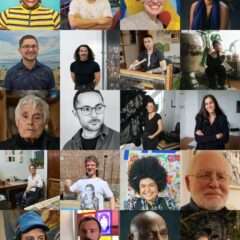There were 21 fairs in Miami last week besides Art Basel Miami Beach (ABMB). Call me a slacker, but I only made it to 6. I quickly eliminated the specialized fairs (works on paper, photography [2], design) and picked the rest out of past experience and/or because I was likely to find Philadelphia artists or dealers.
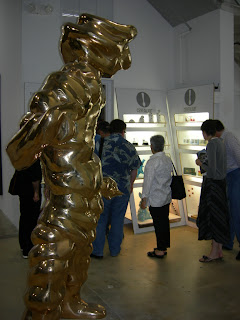
Thomas Schutte Grosse Geister #2 (Big Spirit #2) 2003, polished bronze, in front of the Cerealart display at the Rubell Family Collection
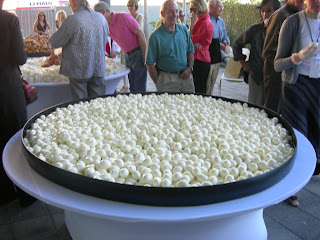
Breakfast at the Rubell Family Collection. That’s not a Richard Long (the Long was on the ground, a hundred feet away; no kidding!) but a platter of boilded eggs. The Rubells don’t do things by halves. All photos in this post by the author, unless noted.
The morning after the opening of ABMB I headed to a breakfast at the Rubell Family Collection. Since ABMB and most of the other fairs don’t open until noon, EVERYONE goes to the Rubells’. It was a fire-marshal’s nightmare but fun, as always, and the food (per Jennifer Rubell) was stylish and funny: a huge (I mean huge – probably at least 6 foot) platter of boiled eggs, another of croissants, and a third with a mound of bacon in the center and white surgical gloves ringing it (to keep the bacon grease from the guests’ fingers; how considerate!).Cerealart (Philadelphia) has a regular presence at the Rubells’, next to the bookshop, and both Larry and Shiya Mangel were at the breakfast showing off the newest item: Kehinde Wiley’s tapestry The Gypsy Fortune-Teller. It was woven in Belgium and Shiya used her training in textile design to translate Wiley’s design, via computer, for the weavers. They produced a delightful print ad shot at the Powell House, with the Wiley hanging over an 18th century table.
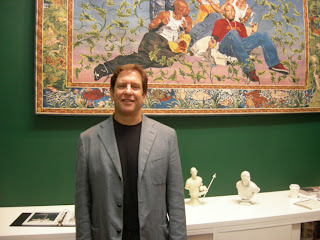
Larry Mangle in front of Kehinde Wiley’s new tapestry for Cerealart
The Rubells always program their 45,000-foot space with curated exhibitions (some of which have toured). One was devoted to nine years’ of work by the young Miami artist Hernan Bas. His latest (and largest) work was a an installation that filled a huge room. Ocean’s Symphony consisted of five video projections as a backdrop for a huge assemblage. In the center was the bier of a miniature mermaid, surrounded by piles of shells and other things washed up from the sea. The videos reminded me of an old Florida tourist attraction: Weeki Wachee Springs, which bills itself as The only city of live mermaids! Since 1947 women have donned costumes with tails and performed for the tourists. I figured Bas was too young to know about it; good thing I asked Jason Rubell, for he told me that Bas had filmed there. The work has no hint of irony; indeed the curatorial statement describes Bas’ work as romantic storytelling, art history references, grand gesture and melding of the conceptual,… How about high kitsch? Weeki Wachee Springs may count as historic, by Florida standards, but hardly art.
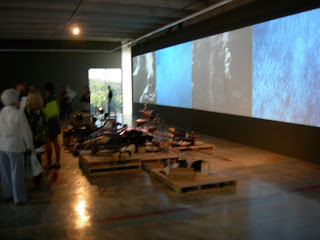
Hernan Bas Ocean’s Symphony 2007, mixed media with video, at the Rubell Family Collection
Just down the block from the Rubells’ was Fountain which bills itself as a guerrilla-style art fair, now in its 2nd year. It was certainly the least formal of the fairs, consisting of a group of young dealers from Williamsburg (Brooklyn, NY), with lots of good work. They were giving out buttons with an image of Duchamp’s urinal (hence the fair’s name). If I’d had a few thousand dollars’ spare change, which wouldn’t have bought me a single large-editioned print at ABMB, I could have put together an entire collection of interesting art. From now on I’ll mostly show pictures, and reduce the editorial comments.
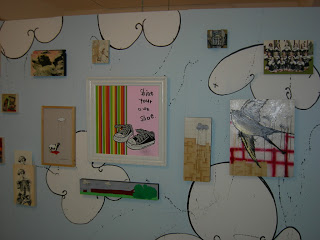
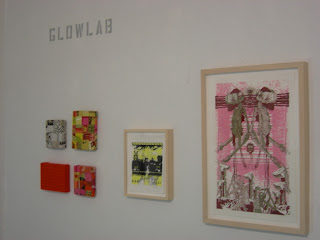
Mark Price’s serigraphs and stretched, printed fabric works at Glowlab
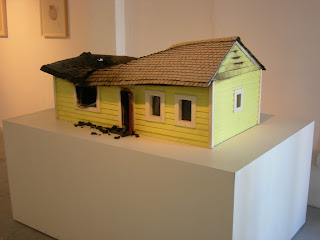
Stephen Lewis Meth Lab at Front Room, a gallery which seems to favor doom and disaster (or maybe it’s just the times). Don’t get me wrong; I liked the work
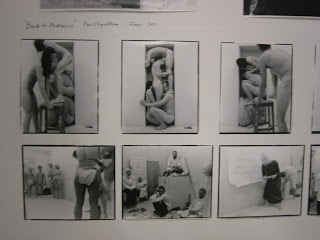
Photo-documentation of Back to Modernism (France 2001) by the Estonian Performance Group, NON-GRATA
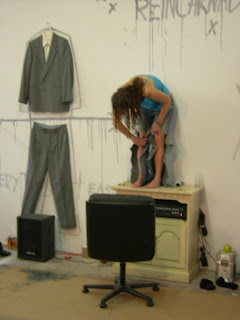
Performance in progress at the Fountain fair by Brooklyn artist, Melissa Lockwood, who joined NON-GRATA during a U.S. tour and has also performed with them in Europe. I assume the suit is a reference to Beuys; not sure whether the clothes-cutting refers to Yoko Ono’s Cut Piee
Then on to Scope, a fair that emphasizes emerging artists and galleries, with a notably international roster. At this point I might mention a few things that I noticed throughout the fairs. No, I’m not suggesting these are trends, merely things that seemed notable:
– lots of work on and with paper; beautiful drawings, both monumental and modest; in fact, my favorite works were often drawings
– much paper-cutting in evidence; usually not a common technique
– many words in phrases or semi-narrative; is this the influence of Richard Prince?
– many maps or map-like images
– dead insects everywhere, either as subjects or actually incorporated into work
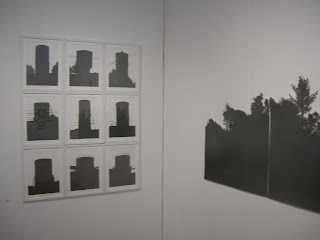
Daniel Alcala’s Paperscapes at Arroniz Arte Contemporaneo (Mexico City). Alcala darkens the paper with graphite before cutting it and that isn’t work by the Becher’s on the left, but Alcala’s homage (take-off?)
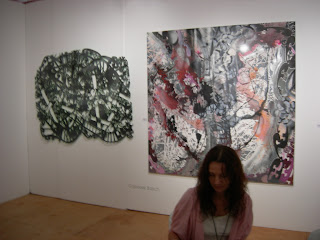
A papercut (l)and oil on canvas (r) by Gabriele Basch at Galerie Haus Schneider (Karlshruhe), which was exhibiting quite a bit of delerious draughtsmanship. Basch’s papercuts have a rhythm of figure to ground reminescent of traditional Chinese papercuts, despite the difference in scale

Judith Schaecter’s back-lit glass and Jennifer Poon’s drawings at Claire Oliver’s booth
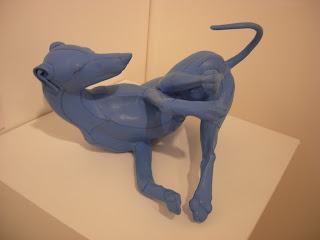
Blue Sophia 2007, leather over taxidermist’s mannequin, by Adelaid Paul, a Philadelphian and 2007 Pew Fellow who’s known for her ceramics, at Dean Projects (Long Island City)
Then on to Aqua Wynwood; this year the fair is split between the Aqua Hotel on Miami Beach and a warehouse in the Wynwood gallery district. I popped in briefly, primarily to see Gallery Joe (Philadelphia).
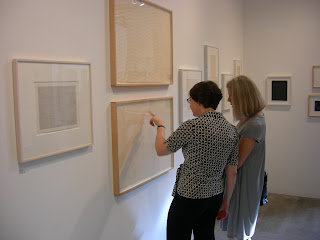
Becky Kerlin pointing something out to a visitor to Gallery Joe’s booth, which exhibited a range of gallery artists and Rob Matthews’ extraordinary Knoxville Girl series
There will be a final post from Miami (three more fairs to go), with lots of pictures.



